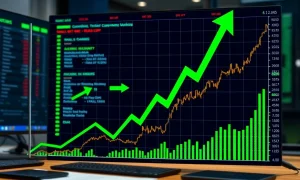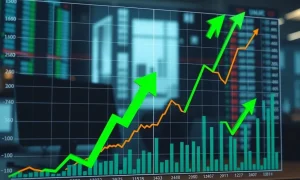For business professionals and entrepreneurs, understanding effective financial instruments is paramount. Over the past century, many innovations have reshaped the investment landscape. Among these, **Exchange-Traded Funds** (ETFs) stand out as truly revolutionary. They offer a unique blend of benefits, making them one of the most impactful financial tools available today. This comprehensive guide explores why Exchange-Traded Funds are so powerful and how they continue to evolve for the modern investor.
Understanding Exchange-Traded Funds
What exactly are **Exchange-Traded Funds**? An ETF is a type of investment fund. It holds assets such as stocks, commodities, or bonds. Most importantly, it trades on stock exchanges. ETFs trade throughout the day, just like ordinary stocks. This characteristic sets them apart from traditional mutual funds. Mutual funds typically price only once per day.
Furthermore, ETFs often track a specific index. For instance, an ETF might track the S&P 500. This means its performance aims to mirror that index. Investors gain broad market exposure through a single investment. Consequently, this simplifies portfolio diversification. ETFs combine the diversification of mutual funds with the trading flexibility of stocks. This combination creates a powerful investment vehicle. They have become incredibly popular due to their structure.
The Advantages of Investing in Exchange-Traded Funds
Investors widely recognize several key benefits of **Exchange-Traded Funds**. These advantages contribute significantly to their appeal. Therefore, understanding these benefits is crucial for any investor.
- Diversification: ETFs inherently offer diversification. A single ETF can hold hundreds or even thousands of underlying assets. This broad exposure reduces risk. It helps investors avoid concentrating their capital in just a few securities.
- Lower Costs: Generally, ETFs feature lower expense ratios than actively managed mutual funds. Their passive management style contributes to these cost savings. Lower fees mean more of your investment returns stay in your pocket. This is a significant long-term advantage.
- Liquidity: ETFs trade on major stock exchanges. Investors can buy and sell them throughout the trading day. This provides excellent liquidity. You can enter or exit positions quickly. This flexibility is a major benefit for many investors.
- Transparency: Most ETFs disclose their holdings daily. This high level of transparency allows investors to know exactly what they own. It promotes informed decision-making. Investors can align their investments with their values.
- Accessibility: ETFs are easily accessible to individual investors. Many brokerage platforms offer commission-free ETF trading. This lowers the barrier to entry for new investors. Therefore, more people can build diversified portfolios.
These benefits collectively make **Exchange-Traded Funds** an attractive option. They suit both novice and experienced investors. Their structure offers a practical approach to market participation.
How Exchange-Traded Funds Compare to Other Investments
To fully appreciate **Exchange-Traded Funds**, it helps to compare them with other common investment vehicles. Each option presents unique characteristics. Understanding these differences aids in making informed choices.
Firstly, consider mutual funds. Mutual funds are professionally managed pools of money. They typically price once a day, after market close. ETFs, conversely, trade like stocks all day. This intraday liquidity is a key distinction. Furthermore, mutual funds often carry higher expense ratios. This is due to their active management. ETFs generally follow a passive index. Therefore, their fees are usually lower. However, some mutual funds may offer tax advantages in specific situations.
Secondly, compare ETFs to individual stocks. Buying individual stocks offers direct ownership in a single company. This can lead to significant gains if the company performs well. However, it also carries higher risk. A single company’s poor performance can severely impact your portfolio. ETFs mitigate this risk through diversification. They spread your investment across many companies. Consequently, your portfolio is less vulnerable to the fortunes of any single entity. Moreover, building a diversified stock portfolio requires substantial capital. ETFs allow diversification with a smaller initial investment.
Finally, bonds also serve as a comparison point. Bonds represent loans made to a borrower. They offer fixed income payments. Bond ETFs, however, provide exposure to a basket of bonds. This diversifies interest rate risk. It also simplifies bond investing. Therefore, for investors seeking diversified exposure to various asset classes, **Exchange-Traded Funds** present a compelling solution. They bridge the gap between individual securities and broad fund investments.
Areas for Improvement in Exchange-Traded Funds
While **Exchange-Traded Funds** offer numerous advantages, they are not without areas for potential improvement. Recognizing these aspects allows for more informed investment strategies. Moreover, it highlights future developments in the ETF market.
One concern revolves around the complexity of certain niche ETFs. Some ETFs track highly specialized or leveraged strategies. These can involve intricate derivatives. Consequently, they may be difficult for average investors to fully comprehend. For instance, leveraged ETFs aim to deliver multiples of an index’s daily return. Inverse ETFs aim to profit from declines. These products carry higher risks. They are generally unsuitable for long-term buy-and-hold investors. Improved education and clearer risk disclosures could benefit investors using these products.
Another area involves potential market impact. The rapid growth of ETFs means they now hold a substantial portion of the market. Some critics suggest this could lead to concentrated ownership. This might exacerbate market volatility during stress events. For example, large outflows from popular ETFs could trigger broader selling pressure. However, this remains a subject of ongoing debate among financial experts. Regulators continually monitor these dynamics.
Furthermore, the issue of ‘closet indexing’ sometimes arises with actively managed ETFs. These funds charge higher fees. Yet, their performance closely tracks a major index. Investors might pay more for active management without receiving true active returns. Greater transparency in active ETF strategies could help address this. Investors need to understand the value proposition clearly. Therefore, while ETFs are powerful, continuous refinement benefits the entire ecosystem.
Navigating the Future of Exchange-Traded Funds
The landscape of **Exchange-Traded Funds** is continuously evolving. Innovations and regulatory shifts shape their future trajectory. Staying informed about these trends helps investors adapt their strategies effectively. The growth of new ETF types is a prominent trend.
Firstly, the rise of actively managed ETFs is notable. Historically, most ETFs were passively managed. They simply tracked an index. However, more fund managers now launch ETFs that employ active strategies. These funds aim to outperform a benchmark. They offer the transparency and trading flexibility of ETFs. At the same time, they provide the potential for alpha generation. This hybrid model represents a significant evolution. Investors gain more choices for their portfolios.
Secondly, environmental, social, and governance (ESG) ETFs are gaining traction. These funds invest in companies that meet specific sustainability criteria. As investor awareness grows, demand for ESG-aligned investments increases. This trend reflects a broader societal shift towards responsible investing. Furthermore, thematic ETFs are also expanding. These focus on specific trends or industries. Examples include cybersecurity, artificial intelligence, or clean energy. They allow investors to target high-growth sectors. Consequently, investors can align their portfolios with future economic drivers.
Finally, regulatory scrutiny remains a constant factor. As the ETF market matures, regulators worldwide refine their frameworks. They aim to ensure market stability and investor protection. This includes rules around leverage, derivatives, and liquidity management. Clearer regulations foster greater confidence in the ETF market. Therefore, the future of **Exchange-Traded Funds** promises continued innovation. It will likely see increased diversification in product offerings. Investors should monitor these developments closely to leverage new opportunities.
In conclusion, **Exchange-Traded Funds** have fundamentally transformed investment access and efficiency. They provide a compelling combination of diversification, low costs, and liquidity. While areas for refinement exist, their continuous evolution underscores their enduring value. For modern investors, understanding and utilizing ETFs remains a cornerstone of a well-constructed financial strategy. They truly are a revolutionary tool, constantly adapting to meet market demands.
Frequently Asked Questions (FAQs) about Exchange-Traded Funds
What is the primary difference between an ETF and a mutual fund?
The primary difference lies in their trading mechanism. ETFs trade throughout the day on stock exchanges, similar to individual stocks. Mutual funds, conversely, are typically priced only once per day, after the market closes. This means you can buy or sell an ETF at its current market price during trading hours, while mutual fund transactions occur at the end-of-day net asset value.
Are Exchange-Traded Funds suitable for long-term investing?
Yes, many Exchange-Traded Funds are highly suitable for long-term investing. Index-tracking ETFs, in particular, offer a cost-effective way to gain diversified exposure to broad market segments over extended periods. Their low expense ratios and inherent diversification make them excellent components of a long-term investment strategy. However, highly specialized or leveraged ETFs may not be suitable for all long-term investors due to their increased risk profiles.
How do I buy Exchange-Traded Funds?
You can buy Exchange-Traded Funds through a brokerage account. Most online brokerage platforms offer a wide selection of ETFs. The process is similar to buying individual stocks: you place an order for the desired ETF shares through your broker. Many platforms also offer commission-free trading for a wide range of ETFs, further reducing investment costs.
What are the potential risks of investing in Exchange-Traded Funds?
While generally considered less risky than individual stocks, ETFs carry certain risks. These include market risk (the value of the underlying assets can decline), tracking error risk (the ETF might not perfectly replicate its index’s performance), and liquidity risk (some less popular ETFs might be harder to sell quickly). Specialized ETFs, such as leveraged or inverse ETFs, carry additional, higher risks due to their complex structures.
Can Exchange-Traded Funds help with portfolio diversification?
Absolutely. Exchange-Traded Funds are an excellent tool for portfolio diversification. A single ETF can hold a wide basket of securities across various industries, sectors, or asset classes. This broad exposure helps to spread risk and reduce the impact of poor performance from any single holding. By investing in different types of ETFs (e.g., stock, bond, commodity, international), investors can create a highly diversified portfolio tailored to their risk tolerance and investment goals.








